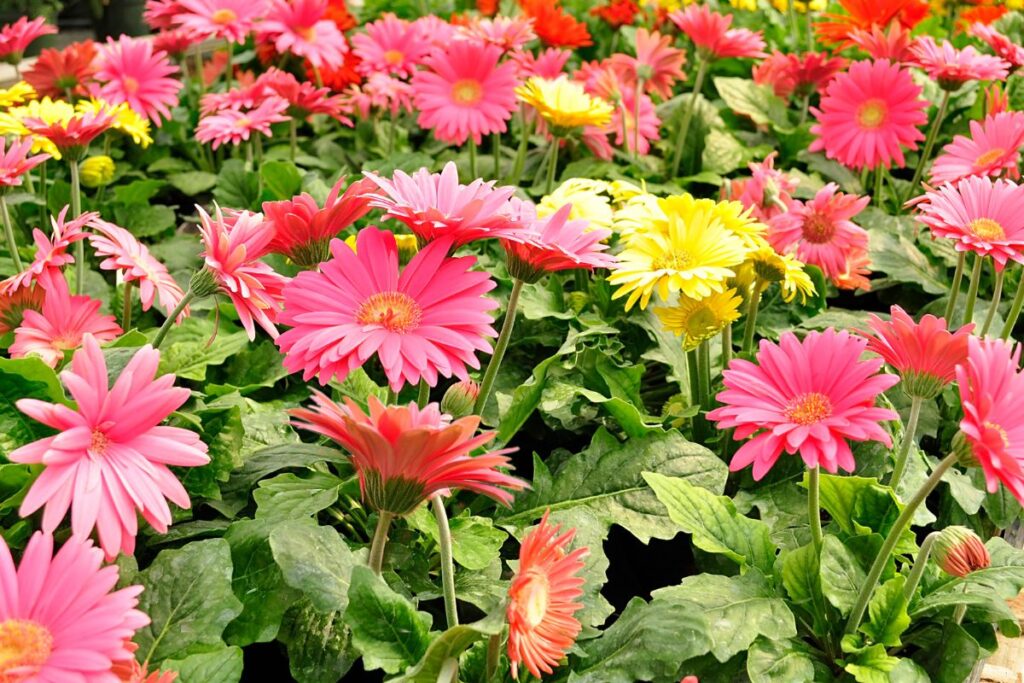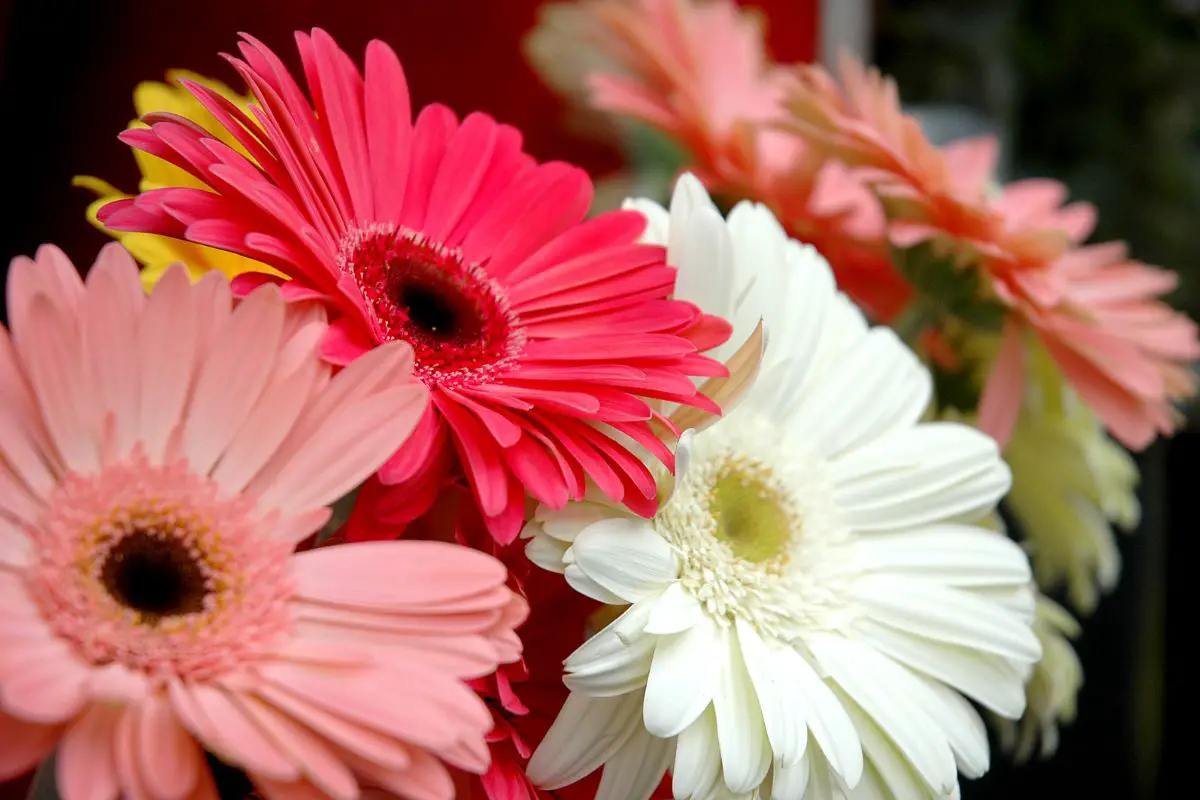Annual, perennial, and biennial plants share many of the same basic qualities. They provide food and shelter for wildlife, especially pollinators like butterflies, bees, moths, and hummingbirds. Also, they both have their place in gardens, landscapes, and our homes.
Table of Contents
Gerbera Daisy, Annual or Perennial?
Native to South Africa, Gerbera jamesonii, commonly known as gerbera daisy, is a tender perennial that will return for several years. Warm climates that are free of frost and hard freezes (growing zones 8 and up) are ideal for growing outdoors for more than one season. Otherwise, they are treated as annuals.
When it comes to selecting plants for your garden, perennials are an excellent choice. These pants are known for their striking flower and foliage hues, minimal upkeep, and their ability to return season after season, year after year. As a result, perennials, such as the gerbera daisy, serve as the cornerstone of any garden, providing nearly effortless beauty with minimum maintenance demands.
Annuals have their benefits as well! Often overlooked by gardening enthusiasts, annuals can be underestimated in their power to add vitality and energy to a space in a short amount of time.
Do Gerbera Daisies Come Back Every Year?
True annuals will go from sprout to flower, to seed, and then die all in the same year. They put all their effort into flowering so that they can eventually produce seeds for next year’s incarnation.
For this reason, annuals give a considerable display of colors with large, showy flowers that will last from spring to fall. Deadheading will often increase their yield and keep them blooming until the first hard frost.
Gerbera daisies are not true annuals. When grown in their native regions and places with a similar climate they will return for several years in a row. When grown in Zones 7 and below they are treated as annuals.
Even though these plants are perennials, they are short-lived. Their average lifespan is only three to five years with a chance of living up to ten years if properly cared for. This is rare, however, and two to three years should be expected.
It is true that these plants are perennials. However, gerbera daisies have much in common with annuals. For example, they will flower the first year taking only eighteen to twenty-four weeks to go from sowing to blooming.
Also, they will bloom abundantly from spring to fall and have large, stunning flowers that come in a variety of colors including many that are bi-colored. They, like many annuals, will benefit from deadheading.
Want to learn how to deadhead gerbera daisies? Check out our article How to Deadhead Gerbera Daisies

Can a Gerbera Daisy be Planted Outside?
The gerbera daisy is one of the most popular cut flowers in the world. Their sturdy stems and long vase life contribute to being used often in floral arrangements, but what makes these plants so popular is their fantastic flowers.
Their huge blooms are 3-4 inches wide and they come in a wide variety of colors. Hybridized versions come in almost every color of the rainbow including pink, orange, purple, red, white, and yellow, and, as we mentioned earlier, bicolored petals that look absolutely stunning.
Many cultivars also display different types of petal arrangements such as single flowers, semi-double flowers, double flowers, and spider flowers. These same traits make them popular potted plants as well.
With such amazing, beautiful flowers why wouldn’t you want them growing in your garden? Well, that may be easier said than done. With their popularity as cut flowers, most varieties are bred for this purpose. Even so, there are many varieties that will do well in the garden.
You can find gerbera daisies as nursery starts or you can start them from seed. While it is possible to grow them year-round in USDA Zones 8-11, most gardeners will grow them as annuals even in these warmer climates.
Even if they only last for one year, gerbera daisies will look wonderful in the garden. Since they like well-draining soil with a particular moisture content, raised beds and containers are good choices when planting outdoors.
Also, because they cannot tolerate cold temperatures, make sure to plant them after there is no chance of frost. If your gerbera daisies do make it to the next year you may want to dig them up and replant them so that the crown of the plant remains slightly above ground level.
Did you know gerberas grow well in pots? Check out our guide for How to Grow Gerbera Daisies in Pots
How to Overwinter Gerbera Daisies
When you live in a warmer climate you may be able to leave your gerbera daisies outside for the winter. For those of us that live in colder climates, digging up your gerbera daisies and bringing them indoors is going to be your best option to help them survive over the winter months and give them the chance of living as the perennials they are.
How To Keep Gerbera Daisies Outside During Winter
Many areas have mild winters where temperatures rarely reach freezing. Even if temperatures sometimes dip below freezing for a few hours, your gerbera daisies may still be safe while planted in the ground by properly preparing the plant and the area around the plant before it gets too cold.
You will want to start before nighttime temperatures drop below forty degrees Fahrenheit. Trim the plant down to a couple of inches above the ground and cover them with several inches of mulch, leaves, or straw. Pine needles also make an excellent covering for your gerbera daisies.
How To Overwinter Gerbera Daisies Indoors
Twelve-inch pots with good drainage holes work well when transplanting your gerbera daisies indoors. Use well-draining potting soil.
The roots of the gerbera daisy are somewhat deep but are easy to dig up with a garden spade. Be careful not to damage the roots. After it is out of the ground, gently brush the soil away from the roots.
Place the plant in the pot with the potting soil and gently tamp it into place to remove air pockets. Keep the plant fairly moist for the first few days to help it survive the transplant.
Gerbera daisies like a lot of light, so find a nice sunny window sill to place the plant. Let the soil dry out slightly before watering, being careful not to over-water.
If you found this flower interesting, check out Brunnera Care
Want to learn about the different colors gerberas come in? Check out Gerbera Colors
Final Thoughts
Gerbera daisies are tender perennial plants that add value to our indoor and outdoor spaces with their amazingly beautiful flowers.
So, is the gerbera daisy annual or perennial? The answer is they are perennials that can be grown as annuals. Even though they are commonly grown to be used as cut flowers and in pots, they can be grown outdoors in raised beds, containers, and along borders.

